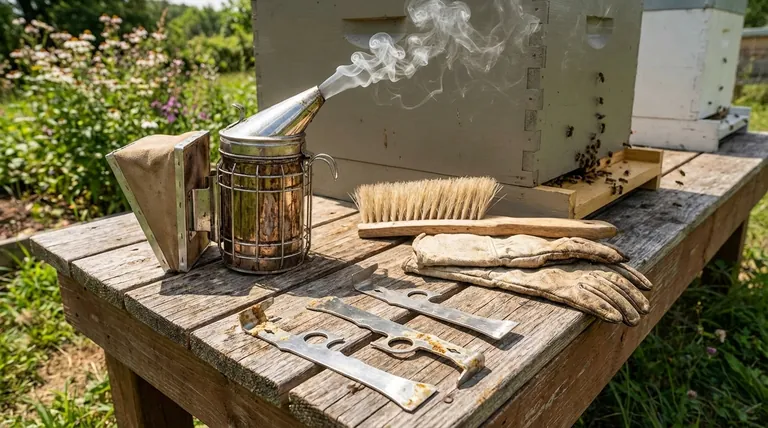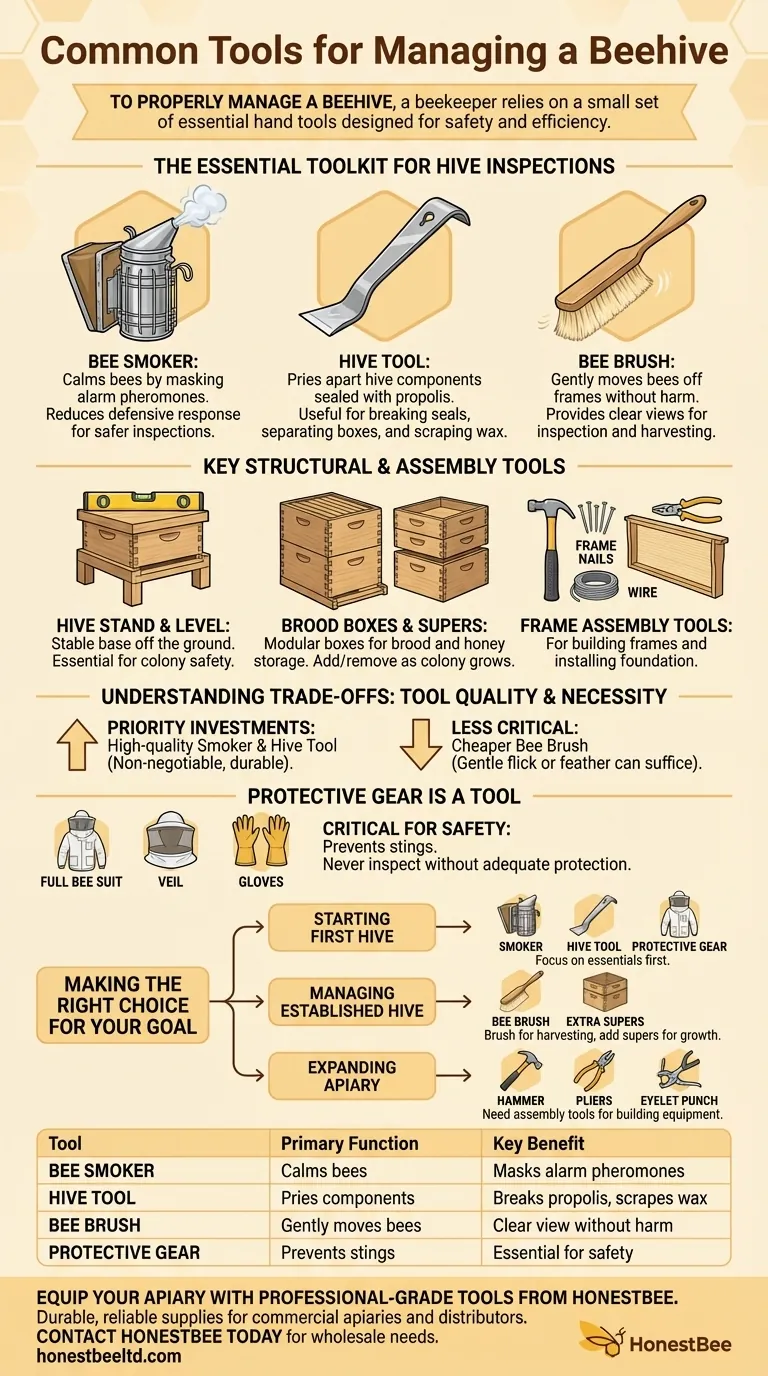To properly manage a beehive, a beekeeper relies on a small set of essential hand tools designed for safety and efficiency. The three most common and critical tools for any hive inspection are the bee smoker, the hive tool, and the bee brush. These instruments allow you to work calmly and effectively with the colony.
While a beehive is a complex system, managing it relies on a few simple, purpose-built tools. Understanding their function is less about the tools themselves and more about learning how to interact with the bees safely and with minimal disruption to the colony.

The Essential Toolkit for Hive Inspections
The primary goal during an inspection is to assess the colony's health, which requires opening the hive and handling its components. These tools make that process possible.
The Bee Smoker
The smoker is widely considered the most important beekeeping tool. A few puffs of cool, white smoke at the hive entrance and under the cover calms the bees. The smoke masks the bees' alarm pheromone, reducing their defensive response and making inspections far easier and safer.
The Hive Tool
Bees use a sticky substance called propolis to seal every crack and seam inside their hive. A hive tool is a small, durable pry bar used to break these seals, separate hive boxes, and lift out frames for inspection. Its flat edge is also useful for scraping away excess wax or propolis.
The Bee Brush
A bee brush has very soft, long bristles designed to gently move bees off a frame without harming them. This is especially useful when you need a clear view of the brood pattern or when harvesting a frame of honey, ensuring you don't carry bees into your processing area.
Key Structural & Assembly Tools
Beyond daily inspections, managing a hive involves working with its physical structure. These components and related tools are fundamental to the hive's stability and growth.
Hive Stand and Level
The hive itself should be placed on a stand to keep it off the damp ground and away from pests. Using a level is essential during setup to ensure the stand is perfectly stable. An unstable hive is a risk to both the colony and the beekeeper.
Brood Boxes and Supers
These are the modular boxes that make up the hive body. The brood box is the lower section where the queen lays her eggs, and the supers are the upper boxes added for honey storage. Managing these involves adding or removing them to give the colony adequate space.
Frame Assembly Tools
Frames are the removable structures inside the boxes where bees build their wax comb. If you are assembling your own, you will need basic tools like a hammer, frame nails, wire, and pliers to build them and install the foundation.
Understanding the Trade-offs: Tool Quality and Necessity
It can be tempting to either buy the cheapest tools available or, conversely, to purchase every gadget on the market. The key is to focus on the essentials first.
Prioritizing Your Purchases
A high-quality smoker and hive tool are non-negotiable investments that will last for years. A cheaper smoker may not stay lit, creating a frustrating and potentially unsafe inspection experience. While a bee brush is useful, a gentle flick of the wrist or a soft feather can serve the same purpose in a pinch.
Protective Gear is a Tool
While not a "hive" tool, personal protective equipment is the most critical tool for the beekeeper. A proper bee suit or jacket, a veil, and gloves are essential for preventing stings. Never attempt a hive inspection without adequate protection, as even a calm colony can become defensive unexpectedly.
Making the Right Choice for Your Goal
Your needs will evolve as you gain experience, but the fundamentals remain the same.
- If your primary focus is starting your first hive: Invest in a quality smoker, a hive tool, and a full set of protective gear before anything else.
- If your primary focus is managing an established hive for honey production: A bee brush becomes more valuable for clearing bees from honey frames, and you will need to add supers as the colony grows.
- If your primary focus is expanding your apiary and building your own equipment: You will need to add assembly tools like a hammer, pliers, and an eyelet punch to your collection.
Ultimately, the best tools are those that allow you to work confidently and respectfully with your bees, ensuring the health of the colony and your own safety.
Summary Table:
| Tool | Primary Function | Key Benefit |
|---|---|---|
| Bee Smoker | Calms bees during inspections | Masks alarm pheromones for safer handling |
| Hive Tool | Pries apart hive components | Breaks propolis seals and scrapes wax |
| Bee Brush | Gently moves bees off frames | Provides clear view without harming bees |
| Protective Gear | Prevents beekeeper stings | Essential for safe interaction with the colony |
Equip your apiary with professional-grade tools from HONESTBEE.
We supply durable, reliable beekeeping supplies and equipment designed for the demands of commercial apiaries and beekeeping equipment distributors. Our wholesale-focused operations ensure you get the quality tools you need to manage your hives safely and efficiently, supporting both colony health and your business's productivity.
Contact HONESTBEE today to discuss your wholesale needs and get the right tools for the job.
Visual Guide

Related Products
- HONESTBEE Advanced Ergonomic Stainless Steel Hive Tool for Beekeeping
- HONESTBEE 15-in-1 Beekeeper Multi-Tool with Hammer and Pliers for Beekeeping
- Professional Drop-Style Hive Handles for Beekeeping
- Professional Replacement Bee Smoker Bellows for Beekeeping Equipment
- Professional Galvanized Hive Strap with Secure Locking Buckle for Beekeeping
People Also Ask
- How should beekeepers handle bees when using a hive tool? Master Calm, Deliberate Techniques
- Why do hive tools have a hole? Unlock the Secret to Efficient Beekeeping
- What is the hole in a hive tool for? A Multi-Tool for Apiary Repairs and Maintenance
- What are the features of a regular hive tool? The Essential Multi-Tool for Every Beekeeper
- What are some common uses of a hive tool? Essential Multi-Purpose Tool for Every Beekeeper



















